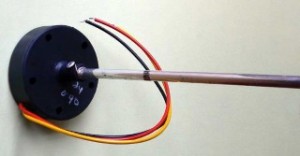My Vans RV-3B has a fifteen gallon fuel tank and Princeton capacitance fuel quantity sensor in each wing. These sensors are connected to a Grand Rapids EIS. As long as I’ve owned her, the fuel quantity indications have been wrong. The fuel flow gauge has done an excellent job as a backup but the quantity indication needed fixed. A couple of recent cross-country flights have reminded me of the importance. Having to cut a leg short out of fear of running out of fuel is not fun – especially when you fill up and find that there was still lots of fuel onboard.
 There are a fair number of negative posts about these sensors which led me to fear that the sensors would need replaced. The following photo gives you a general idea what these sensors look like. They are a huge advance over the old float style sensors.
There are a fair number of negative posts about these sensors which led me to fear that the sensors would need replaced. The following photo gives you a general idea what these sensors look like. They are a huge advance over the old float style sensors.
Before admitting defeat, I decided to try some calibration of my own.
I initially played with the EIS calibration based on the fuel level that I thought was in the tank. This didn’t lead anywhere – basic algebra – starting with an unknown will always leave an unknown. It was obvious I needed to drain the tank. Two options exist for doing this. One is to disconnect the fuel line at the carburetor, raise the airplane to flight attitude, and start pumping. The other sounded like much more fun – fly on one tank until it was empty. I chose the latter. Being a mostly chicken pilot, I chose to do it over an airport – just in case the engine quit and would not restart.
I flew until I thought the tank level was pretty low and then started circling the airport at 10,000′ (field elevation was 6200′). It took much longer than I expected but eventually the fuel flow indication dropped off and the fuel pressure starting doing funny things. I switched tanks and everything returned to normal. I switched back to the empty tank and all “different” indications returned. I left it this way for just a few seconds and I **think** I heard the engine tone starting to change. I then switched back to the non-empty tank and flew home (different airport).
After landing, I raised the tail to flight attitude and added one gallon of fuel. The quantity indicator on the EIS was way off so I calibrated it to read one gallon. I then added a second, third, and so on – the EIS was now reading correctly. At about the six gallon point, the EIS quantity indication stopped changing. I added a total of eight gallons and the EIS never indicated over six and a half gallons.
So, I now have a right fuel tank quantity indicator that is calibrated from six gallons to empty. If the left tank works exactly the same way, I will have accurate fuel level indication for the bottom half of both tanks (approximately). This is plenty sufficient as twelve gallons equates to 1.5 hours at very high cruise to 2 hours at slow cruise. This is plenty of time to make a smart fuel stop decision.
I already feel much more comfortable – that must be the feeling of success!!
I suspect many people want these sensors to read the quantity from zero to full. However; the shape and slope of an aircraft fuel tank makes this mighty difficult. I am happy with what I have.


Leave a Reply